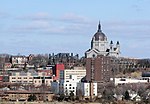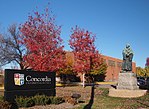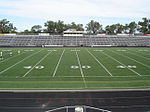Mount Zion Temple
1856 establishments in Minnesota TerritoryBuildings and structures in Saint Paul, MinnesotaErich Mendelsohn buildingsGothic Revival architecture in MinnesotaGothic Revival synagogues ... and 4 more
Jews and Judaism in Minneapolis–Saint PaulReform synagogues in MinnesotaReligious buildings and structures completed in 1953Religious organizations established in 1856

Mount Zion Temple is a Reform synagogue located in St. Paul, Minnesota, United States. Founded in 1856 as Mount Zion Hebrew Association, it was the first Jewish congregation in Minnesota. The congregation was formed before the statehood of Minnesota in 1858.
Excerpt from the Wikipedia article Mount Zion Temple (License: CC BY-SA 3.0, Authors, Images).Mount Zion Temple
Summit Avenue, Saint Paul Macalester - Groveland
Geographical coordinates (GPS) Address Phone number Website External links Nearby Places Show on map
Geographical coordinates (GPS)
| Latitude | Longitude |
|---|---|
| N 44.940833333333 ° | E -93.155277777778 ° |
Address
Mount Zion Temple
Summit Avenue 1300
55105 Saint Paul, Macalester - Groveland
Minnesota, United States
Open on Google Maps








